Mapping and Spatial Variation of Seagrasses in Xincun, Hainan Province, China, Based on Satellite Images
Abstract
:1. Introduction
2. Methods
2.1. Location of the Study Area
2.2. Image Preprocessing
2.3. Classification of Seagrass Distribution Types
2.4. Image Classification Methods
2.5. Error and Accuracy Evaluation
2.6. Spatial and Temporal Variation in Seagrass Distribution
3. Results
3.1. Evaluation of the Accuracy of Seagrass Information Extraction Based on Satellite Images
3.2. Mapping of Seagrass Distribution in the Study Area in 2020 Based on GF2 Images
3.3. Mapping of Seagrass Distribution and Changes in the Study Area from 2016 to 2020 Based on Sentinel-2 Imagery
4. Discussion
4.1. The Effect of Seagrass Mapping Based on GF2 Images
4.2. Status of Seagrass Distribution in the Study Area in 2020
4.3. Spatial and Temporal Variation of Seagrasses in the Study Area from 2016 to 2020
4.4. Main Causes Affecting Seagrass Attenuation in the Study Area
5. Conclusions
Author Contributions
Funding
Acknowledgments
Conflicts of Interest
References
- Unsworth, R.K.F.; McKenzie, L.J.; Collier, C.J.; Cullen-Unsworth, L.C.; Duarte, C.M.; Eklöf, J.S.; Jarvis, J.C.; Jones, B.L.; Nordlund, L.M. Global challenges for seagrass conservation. Ambio 2019, 48, 801–815. [Google Scholar] [CrossRef] [PubMed] [Green Version]
- McKenzie, L.J.; Nordlund, L.M.; Jones, B.L.; Cullen-Unsworth, L.C.; Roelfsema, C.; Unsworth, R.K.F. The global distribution of seagrass meadows. Environ. Res. Lett. 2020, 15, 74041. [Google Scholar] [CrossRef]
- Potouroglou, M.; Bull, J.C.; Krauss, K.W.; Kennedy, H.A.; Fusi, M.; Daffonchio, D.; Mangora, M.M.; Githaiga, M.N.; Diele, K.; Huxham, M. Measuring the role of seagrasses in regulating sediment surface elevation. Sci. Rep. 2017, 7, 11917. [Google Scholar] [CrossRef] [Green Version]
- Fourqurean, J.W.; Duarte, C.M.; Kennedy, H.; Marbà, N.; Holmer, M.; Mateo, M.A.; Apostolaki, E.T.; Kendrick, G.A.; Krause-Jensen, D.; McGlathery, K.J.; et al. Seagrass ecosystems as a globally significant carbon stock. Nat. Geosci. 2012, 5, 505–509. [Google Scholar] [CrossRef]
- Green, A.E.; Unsworth, R.K.F.; Chadwick, M.A.; Jones, P.J.S. Historical Analysis Exposes Catastrophic Seagrass Loss for the United Kingdom. Front. Plant Sci. 2021, 12, 261. [Google Scholar] [CrossRef]
- Short, F.T.; Polidoro, B.; Livingstone, S.R.; Carpenter, K.E.; Bandeira, S.; Bujang, J.S.; Calumpong, H.P.; Carruthers, T.J.B.; Coles, R.G.; Dennison, W.C.; et al. Extinction risk assessment of the world’s seagrass species. Biol. Conserv. 2011, 144, 1961–1971. [Google Scholar] [CrossRef]
- De la Torre-Castro, M.; Di Carlo, G.; Jiddawi, N.S. Seagrass importance for a small-scale fishery in the tropics: The need for seascape management. Mar. Pollut. Bull. 2014, 83, 398–407. [Google Scholar] [CrossRef]
- Nordlund, L.M.; Unsworth, R.K.F.; Gullström, M.; Cullen-Unsworth, L.C. Global significance of seagrass fishery activity. Fish Fish. 2018, 19, 399–412. [Google Scholar] [CrossRef]
- Hossain, M.S.; Bujang, J.S.; Zakaria, M.H.; Hashim, M. The application of remote sensing to seagrass ecosystems: An overview and future research prospects. Int. J. Remote Sens. 2015, 36, 61–114. [Google Scholar] [CrossRef]
- Veettil, B.K.; Ward, R.D.; Lima, M.D.A.C.; Stankovic, M.; Hoai, P.N.; Quang, N.X. Opportunities for seagrass research derived from remote sensing: A review of current methods. Ecol. Indic. 2020, 117, 106560. [Google Scholar] [CrossRef]
- Murray, N.J.; Keith, D.A.; Bland, L.M.; Ferrari, R.; Lyons, M.B.; Lucas, R.; Pettorelli, N.; Nicholson, E. The role of satellite remote sensing in structured ecosystem risk assessments. Sci. Total Environ. 2018, 619–620, 249–257. [Google Scholar] [CrossRef] [PubMed] [Green Version]
- Zoffoli, M.L.; Gernez, P.; Godet, L.; Peters, S.; Oiry, S.; Barillé, L. Decadal increase in the ecological status of a North-Atlantic intertidal seagrass meadow observed with multi-mission satellite time-series. Ecol. Indic. 2021, 130, 108033. [Google Scholar] [CrossRef]
- Wicaksono, P.; Salivian Wisnu Kumara, I.; Kamal, M.; Afif Fauzan, M.; Zhafarina, Z.; Agus Nurswantoro, D.; Noviaris Yogyantoro, R. Multispectral Resampling of Seagrass Species Spectra: WorldView-2, Quickbird, Sentinel-2A, ASTER VNIR, and Landsat 8 OLI. IOP conference series. Earth Environ. Sci. 2017, 98, 12039. [Google Scholar] [CrossRef]
- Kovacs, E.; Roelfsema, C.; Lyons, M.; Zhao, S.; Phinn, S. Seagrass habitat mapping: How do Landsat 8 OLI, Sentinel-2, ZY-3A, and Worldview-3 perform? Remote Sens. Lett. 2018, 9, 686–695. [Google Scholar] [CrossRef]
- Garcia, R.; Hedley, J.; Tin, H.; Fearns, P. A Method to Analyze the Potential of Optical Remote Sensing for Benthic Habitat Mapping. Remote Sens. 2015, 7, 13157–13189. [Google Scholar] [CrossRef] [Green Version]
- Baumstark, R.; Duffey, R.; Pu, R. Mapping seagrass and colonized hard bottom in Springs Coast, Florida using WorldView-2 satellite imagery. Estuar. Coast. Shelf Sci. 2016, 181, 83–92. [Google Scholar] [CrossRef]
- Pu, R.; Bell, S. Mapping seagrass coverage and spatial patterns with high spatial resolution IKONOS imagery. Int. J. Appl. Earth Obs. Geoinf. 2017, 54, 145–158. [Google Scholar] [CrossRef]
- Poursanidis, D.; Topouzelis, K.; Chrysoulakis, N. Mapping coastal marine habitats and delineating the deep limits of the Neptune’s seagrass meadows using very high resolution Earth observation data. Int. J. Remote Sens. 2018, 39, 8670–8687. [Google Scholar] [CrossRef]
- Siregar, V.P.; Agus, S.B.; Subarno, T.; Prabowo, N.W. Mapping shallow waters habitats using OBIA by applying several approaches of depth invariant index in North Kepulauan Seribu. IOP conference series. Earth Environ. Sci. 2018, 149, 12052. [Google Scholar]
- Wicaksono, P.; Lazuardi, W. Assessment of PlanetScope images for benthic habitat and seagrass species mapping in a complex optically shallow water environment. Int. J. Remote Sens. 2018, 39, 5739–5765. [Google Scholar] [CrossRef]
- Papakonstantinou, A.; Stamati, C.; Topouzelis, K. Comparison of True-Color and Multispectral Unmanned Aerial Systems Imagery for Marine Habitat Mapping Using Object-Based Image Analysis. Remote Sens. 2020, 12, 554. [Google Scholar] [CrossRef] [Green Version]
- Rende, S.F.; Bosman, A.; Di Mento, R.; Bruno, F.; Lagudi, A.; Irving, A.D.; Dattola, L.; Giambattista, L.D.; Lanera, P.; Proietti, R.; et al. Ultra-High-Resolution Mapping of Posidonia oceanica (L.) Delile Meadows through Acoustic, Optical Data and Object-based Image Classification. J. Mar. Sci. Eng. 2020, 8, 647. [Google Scholar] [CrossRef]
- Traganos, D.; Reinartz, P. Mapping Mediterranean seagrasses with Sentinel-2 imagery. Mar. Pollut. Bull. 2018, 134, 197–209. [Google Scholar] [CrossRef] [PubMed] [Green Version]
- Traganos, D.; Reinartz, P. Machine learning-based retrieval of benthic reflectance and Posidonia oceanica seagrass extent using a semi-analytical inversion of Sentinel-2 satellite data. Int. J. Remote Sens. 2018, 39, 9428–9452. [Google Scholar] [CrossRef]
- Immordino, F.; Barsanti, M.; Candigliota, E.; Cocito, S.; Delbono, I.; Peirano, A. Application of Sentinel-2 Multispectral Data for Habitat Mapping of Pacific Islands: Palau Republic (Micronesia, Pacific Ocean). J. Mar. Sci. Eng. 2019, 7, 316. [Google Scholar] [CrossRef] [Green Version]
- Ha, N.T.; Manley-Harris, M.; Pham, T.D.; Hawes, I. A Comparative Assessment of Ensemble-Based Machine Learning and Maximum Likelihood Methods for Mapping Seagrass Using Sentinel-2 Imagery in Tauranga Harbor, New Zealand. Remote Sens. 2020, 12, 355. [Google Scholar] [CrossRef] [Green Version]
- Kuhwald, K.; Schneider Von Deimling, J.; Schubert, P.; Oppelt, N. How can Sentinel-2 contribute to seagrass mapping in shallow, turbid Baltic Sea waters? Remote Sens. Ecol. Conserv. 2021. [Google Scholar] [CrossRef]
- Zoffoli, M.L.; Gernez, P.; Rosa, P.; Le Bris, A.; Brando, V.E.; Barillé, A.; Harin, N.; Peters, S.; Poser, K.; Spaias, L.; et al. Sentinel-2 remote sensing of Zostera noltei-dominated intertidal seagrass meadows. Remote Sens. Environ. 2020, 251, 112020. [Google Scholar] [CrossRef]
- Meyer, C.A.; Pu, R. Seagrass resource assessment using remote sensing methods in St. Joseph Sound and Clearwater Harbor, Florida, USA. Environ. Monit. Assess. 2012, 184, 1131–1143. [Google Scholar] [CrossRef]
- Pu, R.; Bell, S.; Meyer, C. Mapping and assessing seagrass bed changes in Central Florida’s west coast using multitemporal Landsat TM imagery. Estuar. Coast. Shelf Sci. 2014, 149, 68–79. [Google Scholar] [CrossRef]
- Ventura, D.; Bonifazi, A.; Gravina, M.F.; Belluscio, A.; Ardizzone, G. Mapping and Classification of Ecologically Sensitive Marine Habitats Using Unmanned Aerial Vehicle (UAV) Imagery and Object-Based Image Analysis (OBIA). Remote Sens. 2018, 10, 1331. [Google Scholar] [CrossRef] [Green Version]
- Fengying, Z.; Guanglong, Q.; Hangqing, F.; Wei, Z. Diversity, distribution and conservation of Chinese seagrass species:Diversity, distribution and conservation of Chinese seagrass species. Biodivers. Sci. 2013, 21, 571. [Google Scholar]
- Huang, X.; Huang, L.; Li, Y.; Xu, Z.; Fong, C.W.; Huang, D.; Han, Q.; Huang, H.; Tan, Y.; Liu, S. Main seagrass beds and threats to their habitats in the coastal sea of South China. Chin. Sci. Bull. 2006, 51 (Suppl. S2), 136–142. [Google Scholar] [CrossRef]
- Xiao, X.; Huang, Y.; Holmer, M. Current trends in seagrass research in China (2010–2019). Aquat. Bot. 2020, 166, 103266. [Google Scholar] [CrossRef]
- Sudo, K.; Quiros, T.E.A.L.; Prathep, A.; Luong, C.V.; Lin, H.; Bujang, J.S.; Ooi, J.L.S.; Fortes, M.D.; Zakaria, M.H.; Yaakub, S.M.; et al. Distribution, Temporal Change, and Conservation Status of Tropical Seagrass Beds in Southeast Asia: 2000–2020. Front. Mar. Sci. 2021, 8, 779. [Google Scholar] [CrossRef]
- Yang, D.; Yang, C. Detection of Seagrass Distribution Changes from 1991 to 2006 in Xincun Bay, Hainan, with Satellite Remote Sensing. Sensors 2009, 9, 830–844. [Google Scholar] [CrossRef]
- Xu, S.; Xu, S.; Zhou, Y.; Yue, S.; Zhang, X.; Gu, R.; Zhang, Y.; Qiao, Y.; Liu, M. Long-Term Changes in the Unique and Largest Seagrass Meadows in the Bohai Sea (China) Using Satellite (1974–2019) and Sonar Data: Implication for Conservation and Restoration. Remote Sens. 2021, 13, 856. [Google Scholar] [CrossRef]
- Zhang, J.; Huang, X.; Jiang, Z. Physiological responses of the seagrass Thalassia hemprichii (Ehrenb.) Aschers as indicators of nutrient loading. Mar. Pollut. Bull. 2014, 83, 508–515. [Google Scholar] [CrossRef]
- Jiang, Z.; Liu, S.; Zhang, J.; Wu, Y.; Zhao, C.; Lian, Z.; Huang, X. Eutrophication indirectly reduced carbon sequestration in a tropical seagrass bed. Plant Soil 2018, 426, 135–152. [Google Scholar] [CrossRef]
- Liu, S.; Jiang, Z.; Wu, Y.; Zhang, J.; Arbi, I.; Ye, F.; Huang, X.; Macreadie, P.I. Effects of nutrient load on microbial activities within a seagrass-dominated ecosystem: Implications of changes in seagrass blue carbon. Mar. Pollut. Bull. 2017, 117, 214–221. [Google Scholar] [CrossRef]
- Liu, S.; Jiang, Z.; Deng, Y.; Wu, Y.; Zhang, J.; Zhao, C.; Huang, D.; Huang, X.; Trevathan-Tackett, S.M. Effects of nutrient loading on sediment bacterial and pathogen communities within seagrass meadows. MicrobiologyOpen 2018, 7, e00600. [Google Scholar] [CrossRef] [PubMed]
- Sagawa, T.; Boisnier, E.; Komatsu, T.; Mustapha, K.B.; Hattour, A.; Kosaka, N.; Miyazaki, S. Using bottom surface reflectance to map coastal marine areas: A new application method for Lyzenga’s model. Int. J. Remote Sens. 2010, 31, 3051–3064. [Google Scholar] [CrossRef]
- Chen, C.; Lau, V.; Chang, N.; Son, N.; Tong, P.; Chiang, S. Multi-temporal change detection of seagrass beds using integrated Landsat TM/ETM+/OLI imageries in Cam Ranh Bay, Vietnam. Ecol. Inform. 2016, 35, 43–54. [Google Scholar] [CrossRef]
- Vanhellemont, Q. Adaptation of the dark spectrum fitting atmospheric correction for aquatic applications of the Landsat and Sentinel-2 archives. Remote Sens. Environ. 2019, 225, 175–192. [Google Scholar] [CrossRef]
- Vanhellemont, Q.; Ruddick, K. Atmospheric correction of metre-scale optical satellite data for inland and coastal water applications. Remote Sens. Environ. 2018, 216, 586–597. [Google Scholar] [CrossRef]
- Valle, M.; Palà, V.; Lafon, V.; Dehouck, A.; Garmendia, J.M.; Borja, Á.; Chust, G. Mapping estuarine habitats using airborne hyperspectral imagery, with special focus on seagrass meadows. Estuar. Coast. Shelf Sci. 2015, 164, 433–442. [Google Scholar] [CrossRef]
- Barillé, L.; Robin, M.; Harin, N.; Bargain, A.; Launeau, P. Increase in seagrass distribution at Bourgneuf Bay (France) detected by spatial remote sensing. Aquat. Bot. 2010, 92, 185–194. [Google Scholar] [CrossRef]
- Calleja, F.; Galván, C.; Silió-Calzada, A.; Juanes, J.A.; Ondiviela, B. Long-term analysis of Zostera noltei: A retrospective approach for understanding seagrasses’ dynamics. Mar. Environ. Res. 2017, 130, 93–105. [Google Scholar] [CrossRef]
- Lyzenga, D.R. Passive remote sensing techniques for mapping water depth and bottom features. Appl. Opt. 1978, 17, 379. [Google Scholar] [CrossRef]
- Kim, K.; Choi, J.; Ryu, J.; Jeong, H.J.; Lee, K.; Park, M.G.; Kim, K.Y. Observation of typhoon-induced seagrass die-off using remote sensing. Estuar. Coast. Shelf Sci. 2015, 154, 111–121. [Google Scholar] [CrossRef]
- Wicaksono, P.; Fauzan, M.A.; Kumara, I.S.W.; Yogyantoro, R.N.; Lazuardi, W.; Zhafarina, Z. Analysis of reflectance spectra of tropical seagrass species and their value for mapping using multispectral satellite images. Int. J. Remote Sens. 2019, 40, 8955–8978. [Google Scholar] [CrossRef]
- Yang, D.; Huang, D. Impacts of Typhoons Tianying and Dawei on seagrass distribution in Xincun Bay, Hainan Province, China. Acta Oceanol. Sin. 2011, 30, 32–39. [Google Scholar] [CrossRef]
- Hauxwell, J.; Cebrián, J.; Valiela, I. Eelgrass Zostera marina loss in temperate estuaries: Relationship to land-derived nitrogen loads and effect of light limitation imposed by algae. Mar. Ecol. Prog. Ser. 2003, 247, 59–73. [Google Scholar] [CrossRef] [Green Version]
- Ruiz, J.M.; Marco-Méndez, C.; Sánchez-Lizaso, J.L. Remote influence of off-shore fish farm waste on Mediterranean seagrass (Posidonia oceanica) meadows. Mar. Environ. Res. 2010, 69, 118–126. [Google Scholar] [CrossRef] [PubMed]
- Fertig, B.; Kennish, M.J.; Sakowicz, G.P. Changing eelgrass (Zostera marina L.) characteristics in a highly eutrophic temperate coastal lagoon. Aquat. Bot. 2013, 104, 70–79. [Google Scholar] [CrossRef]
- Zheng, J.; Gu, X.; Zhang, T.; Liu, H.; Ou, Q.; Peng, C. Phytotoxic effects of Cu, Cd and Zn on the seagrass Thalassia hemprichii and metal accumulation in plants growing in Xincun Bay, Hainan, China. Ecotoxicology 2018, 27, 517–526. [Google Scholar] [CrossRef]
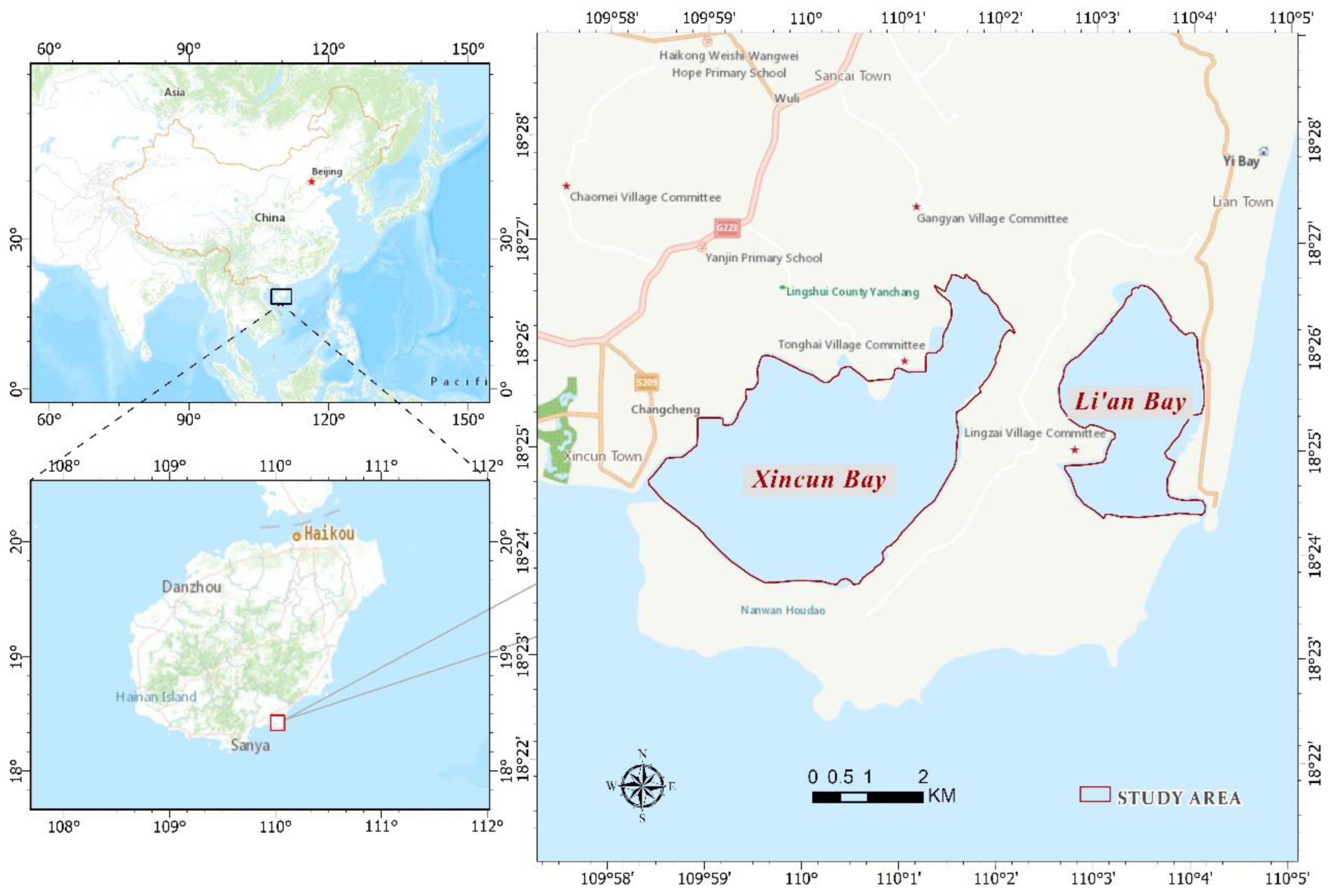
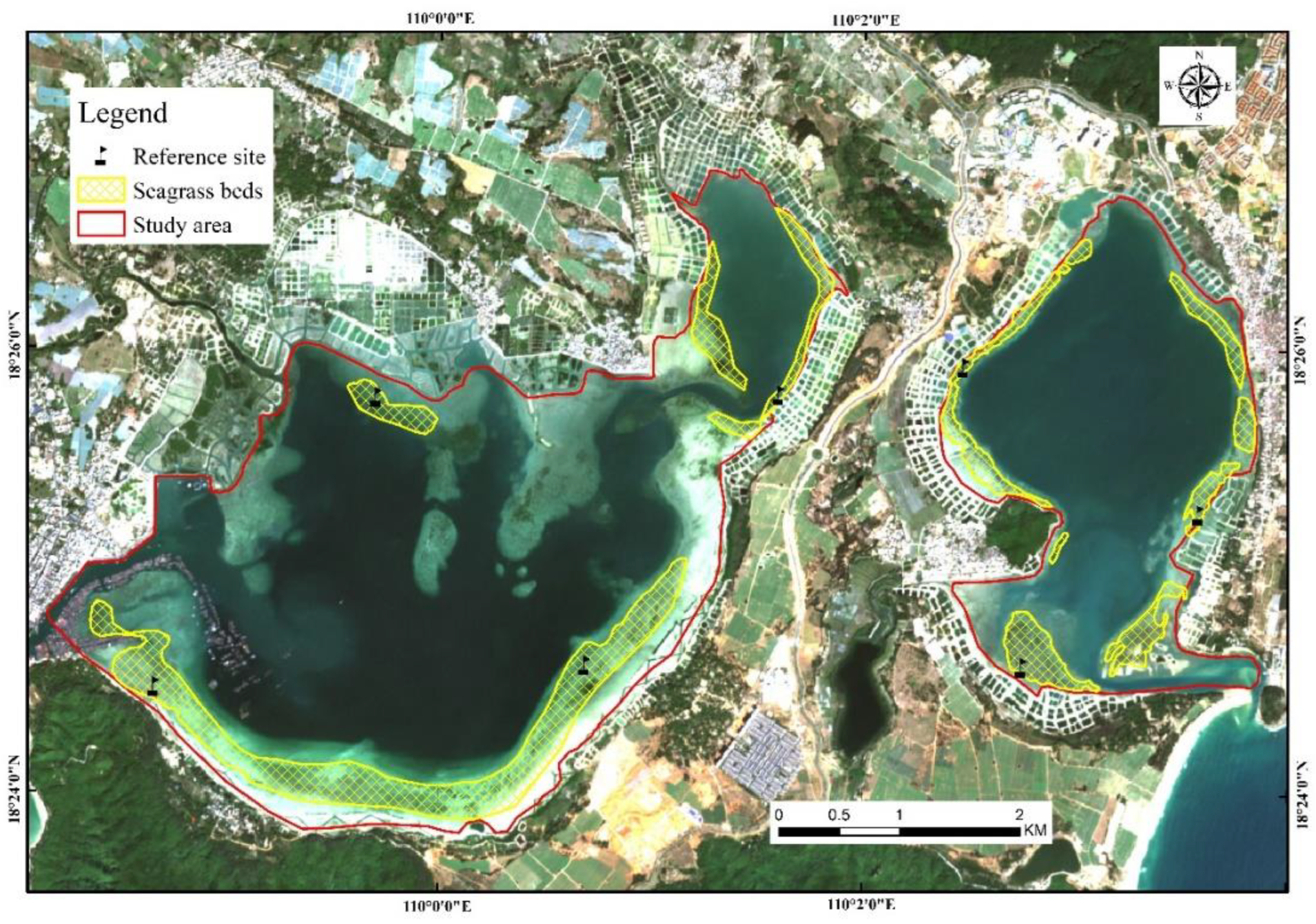
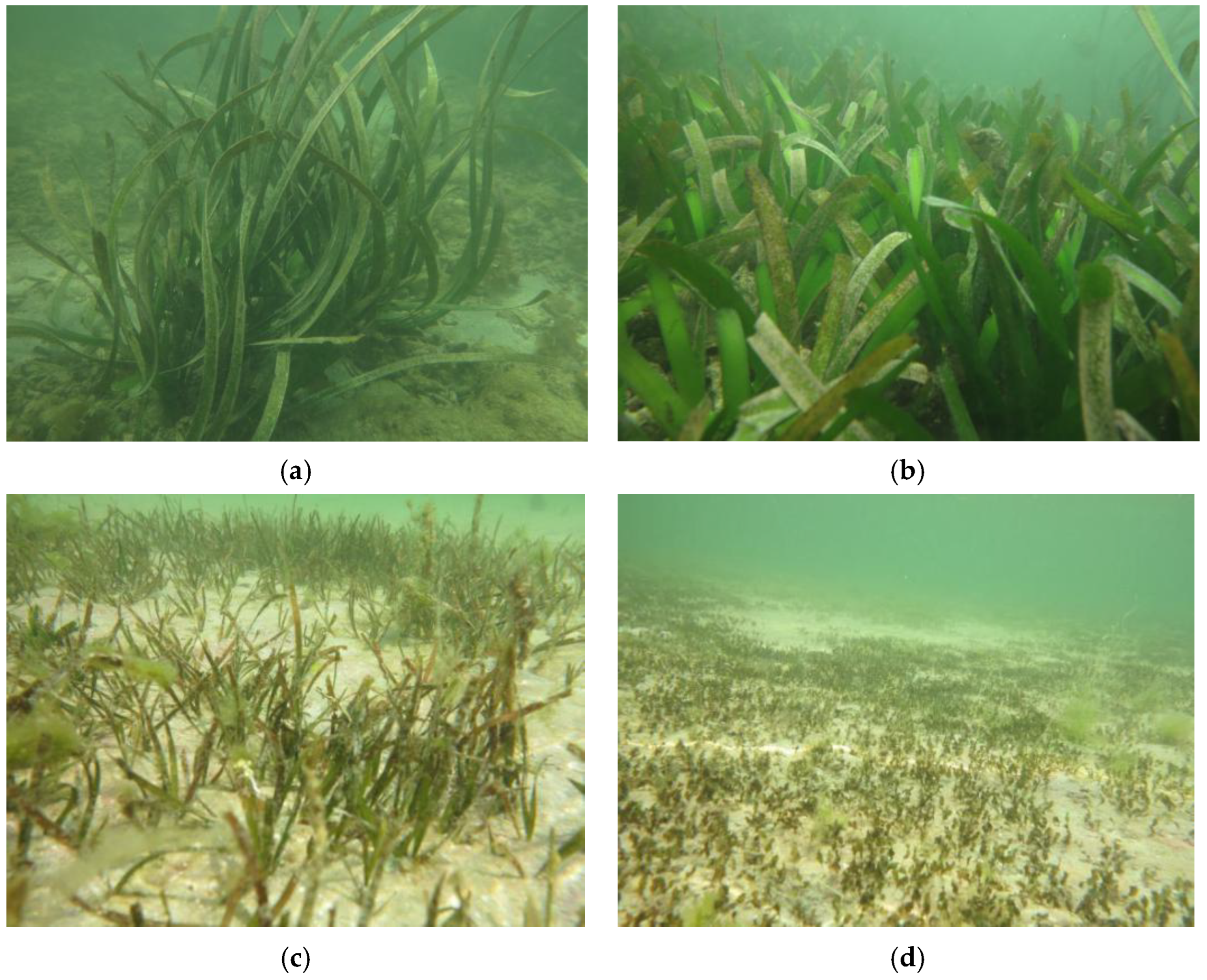
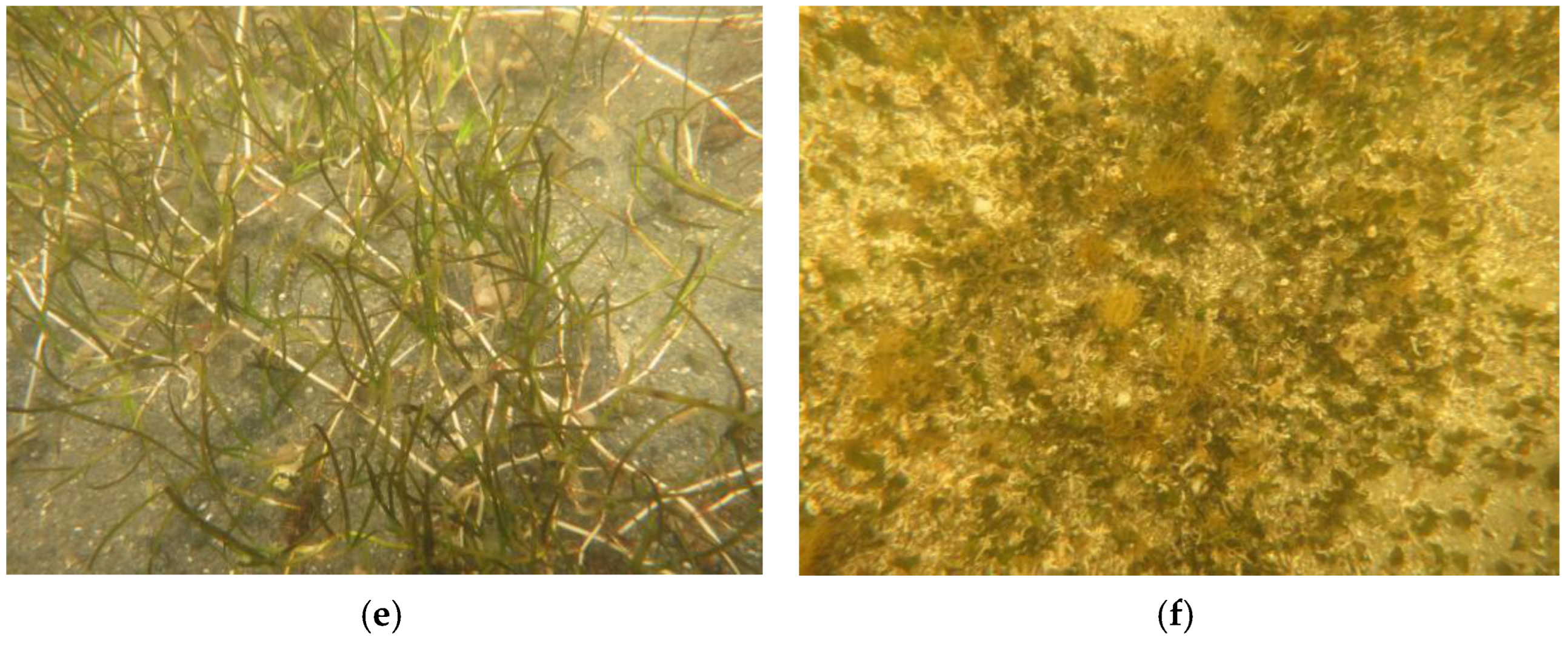
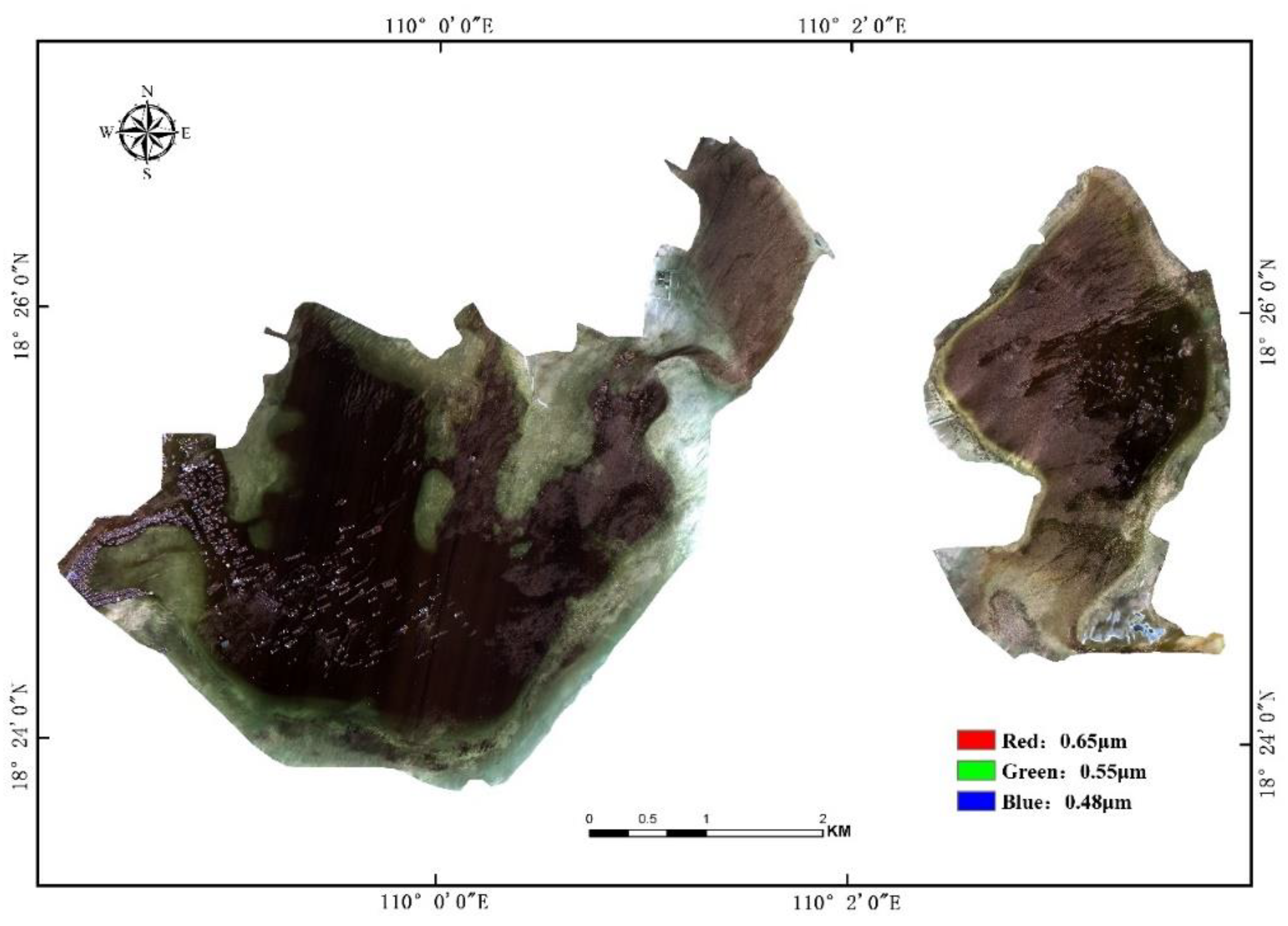
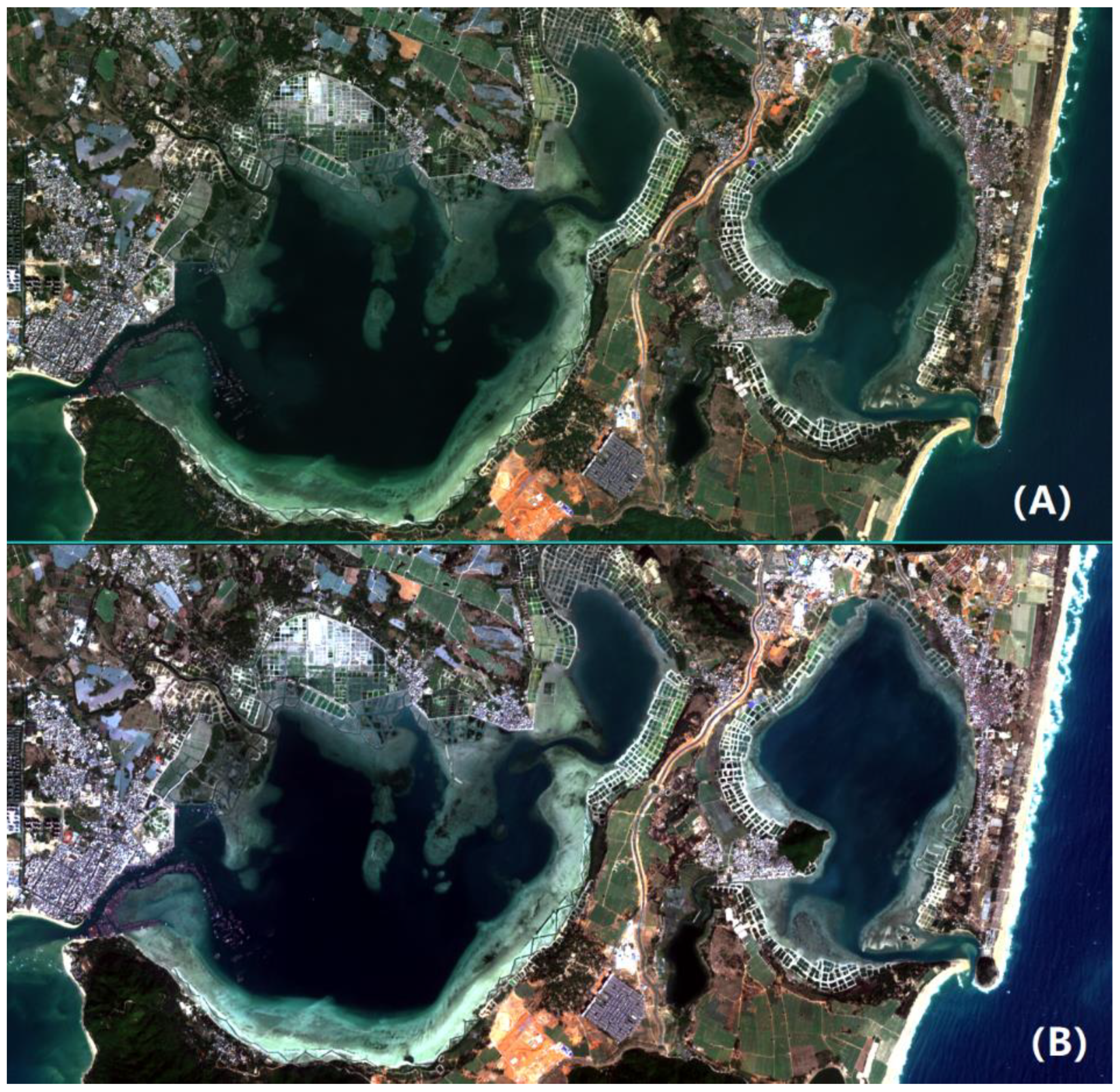

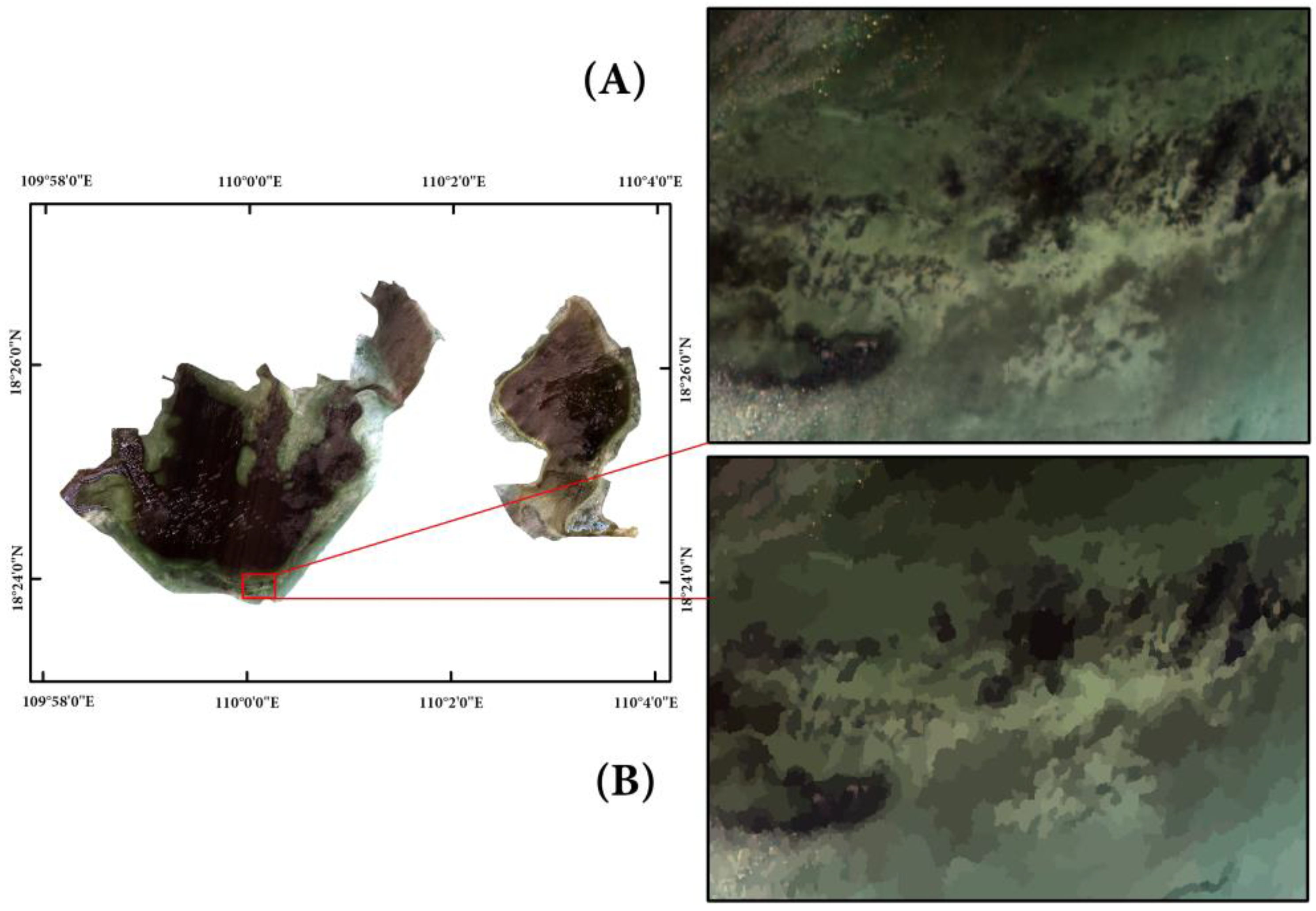

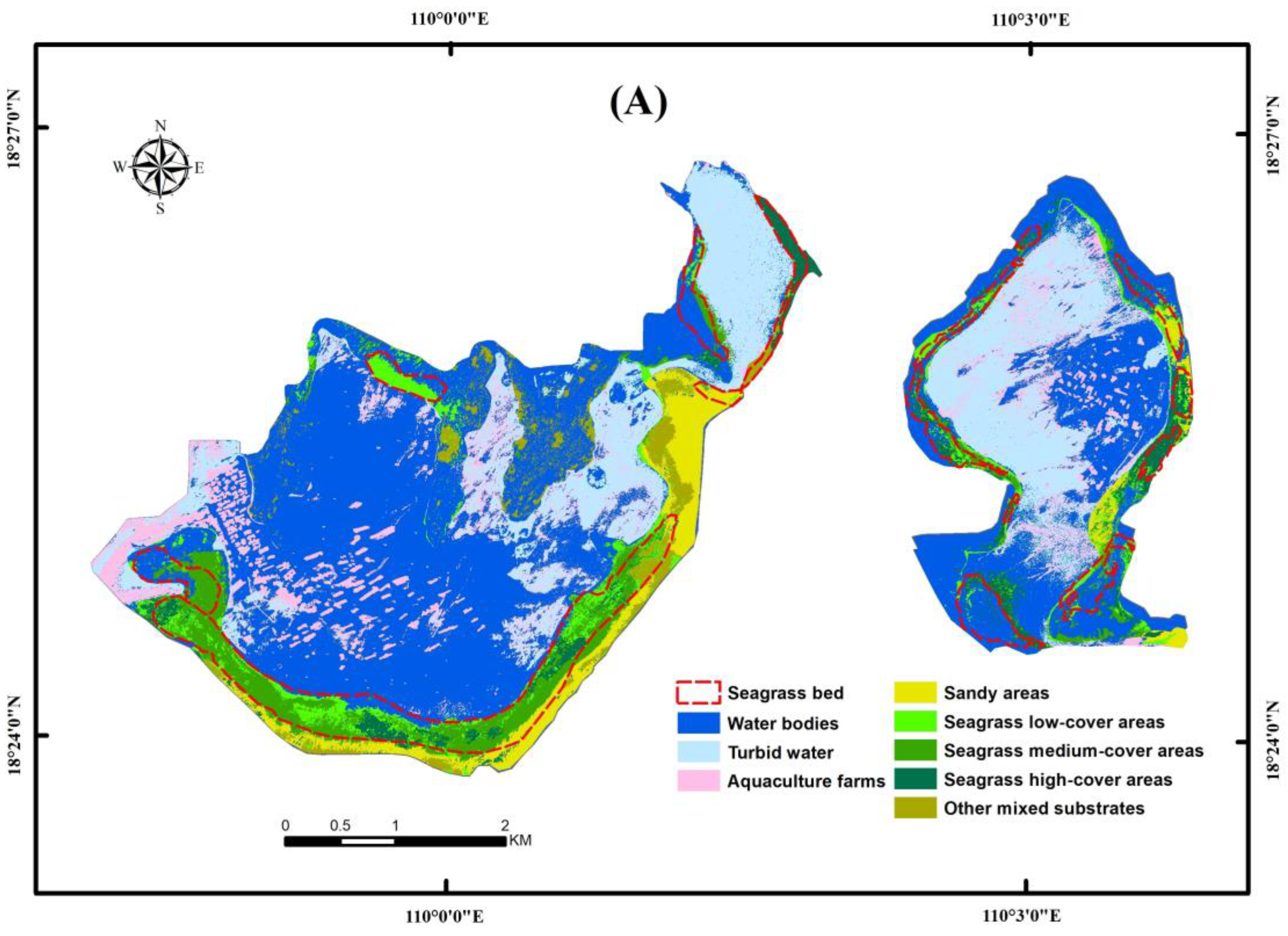
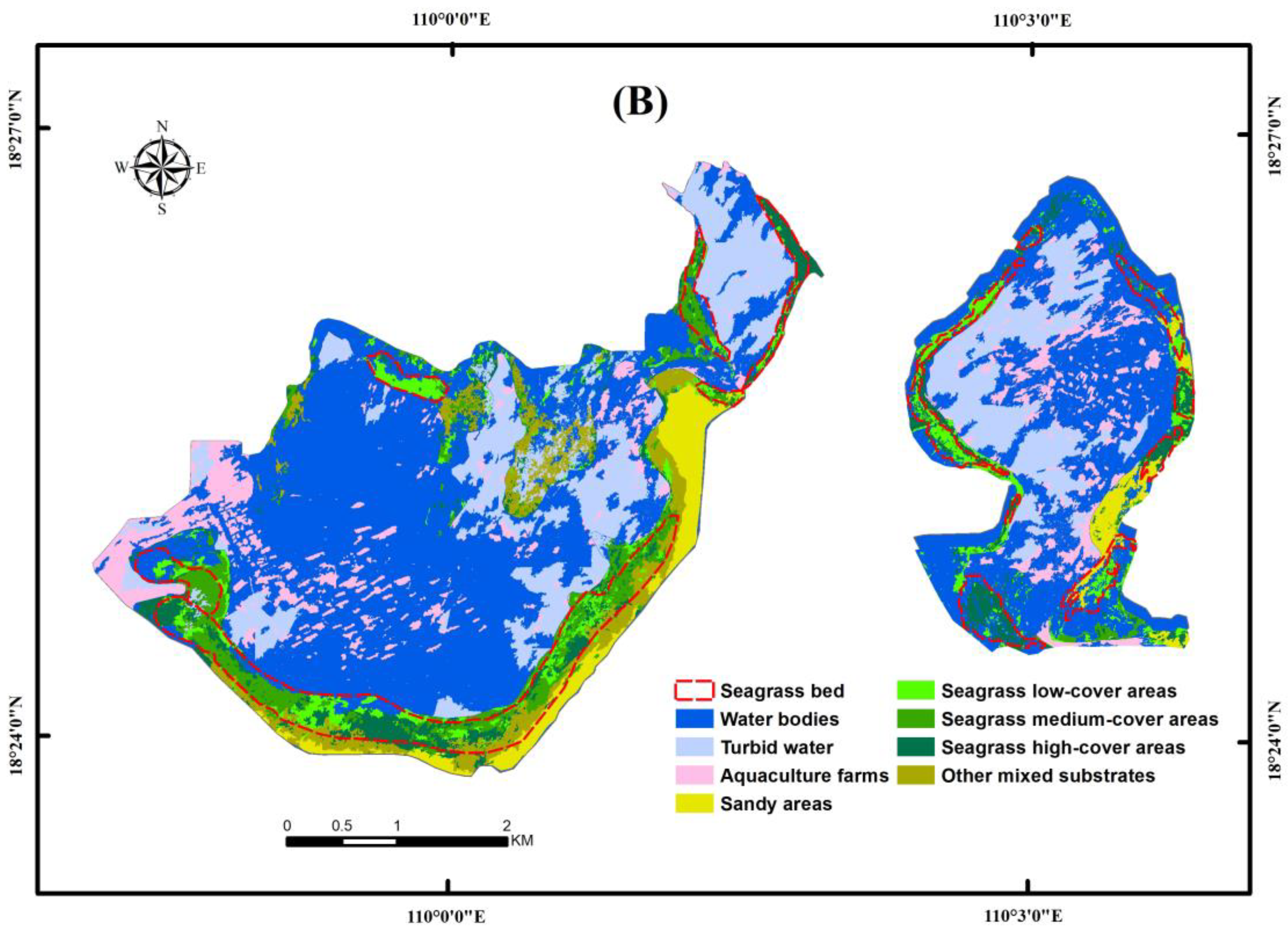
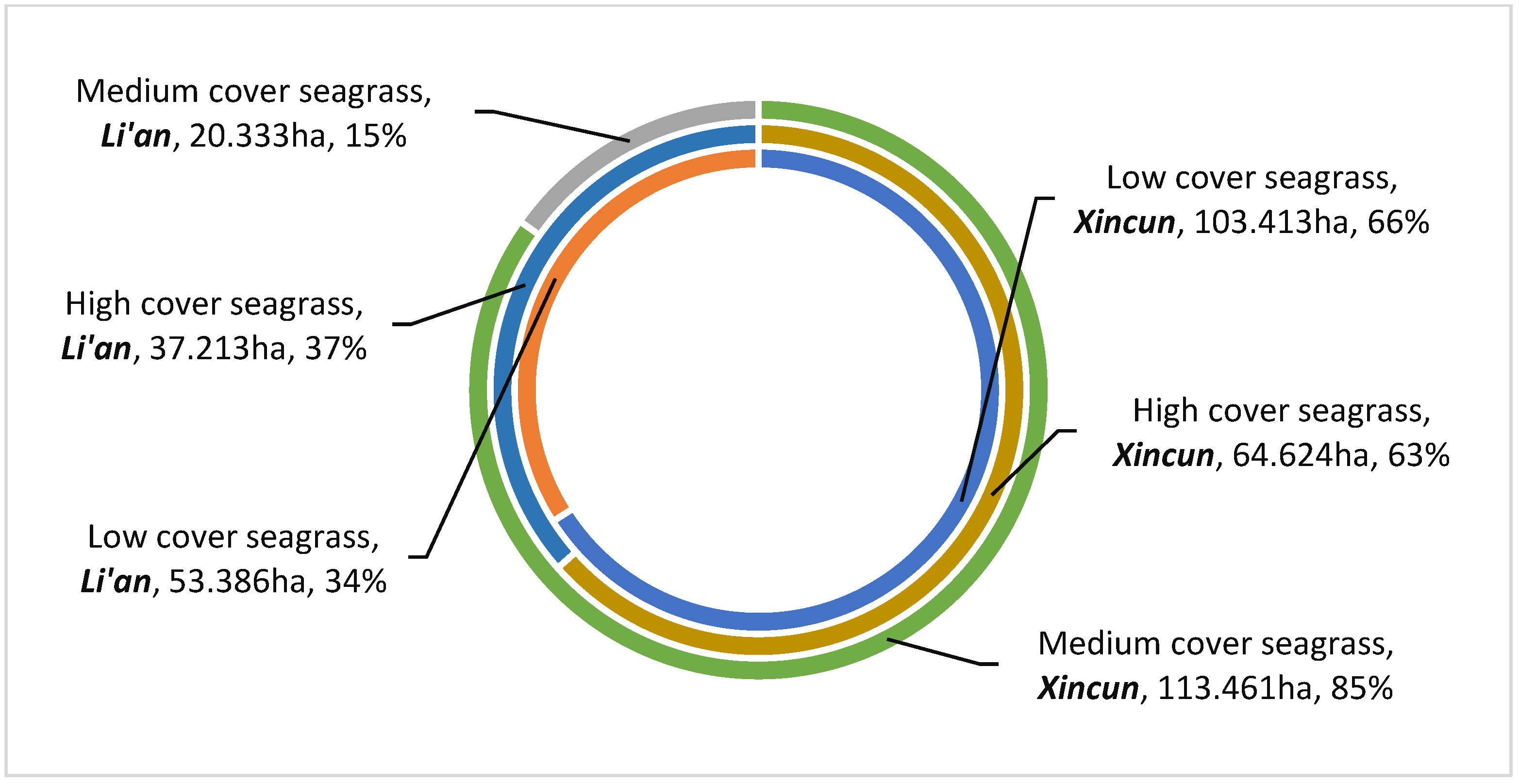
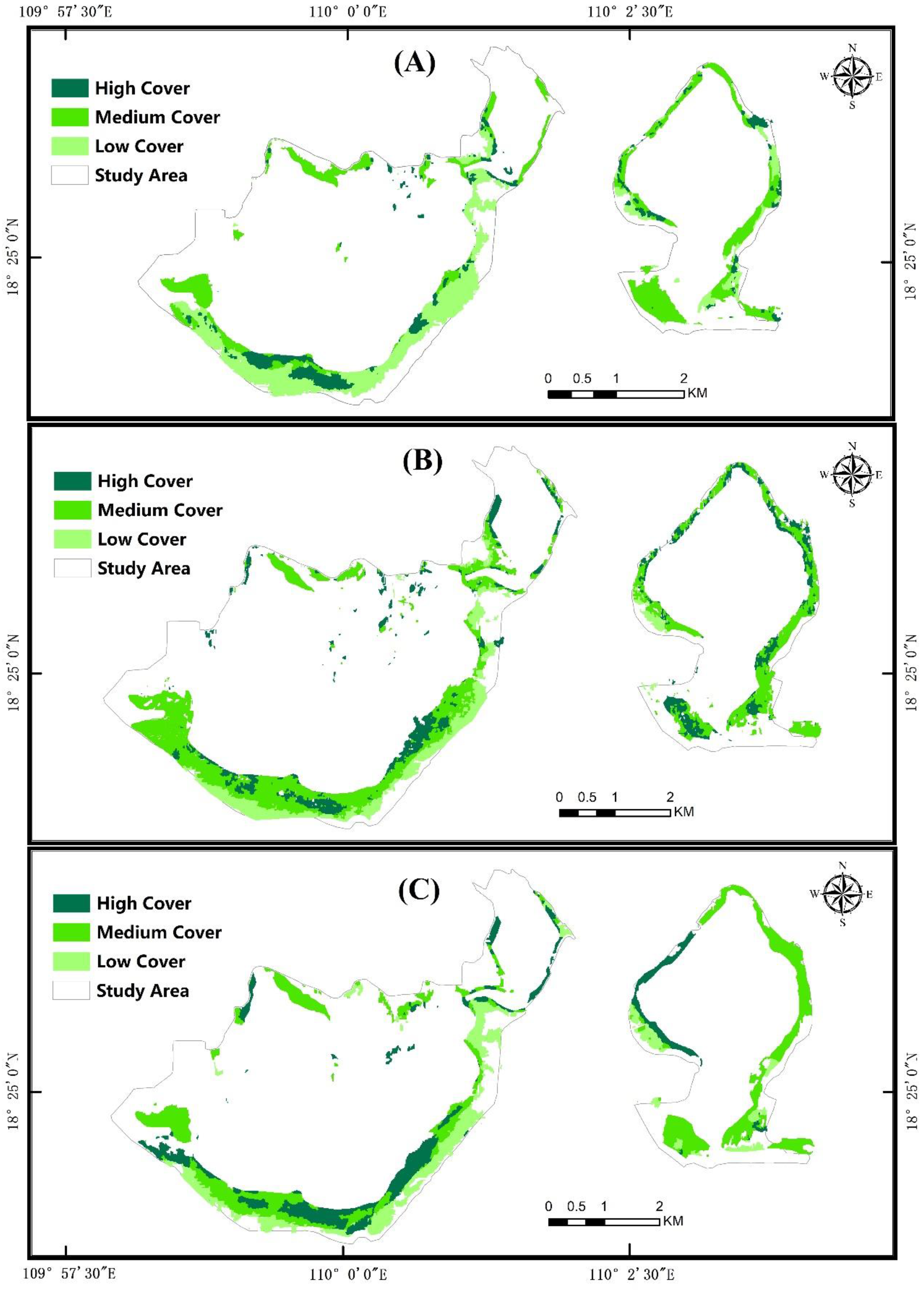
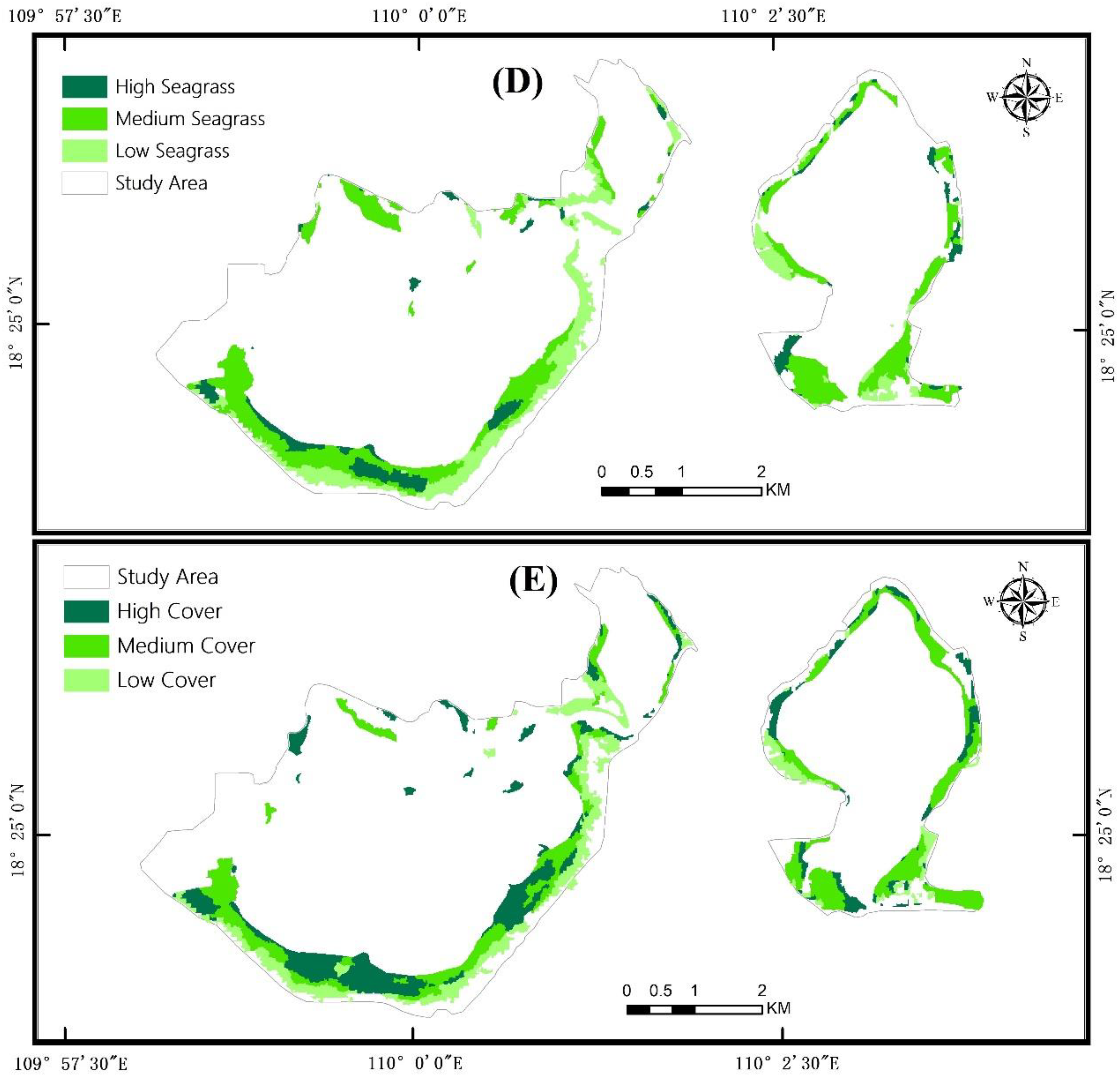


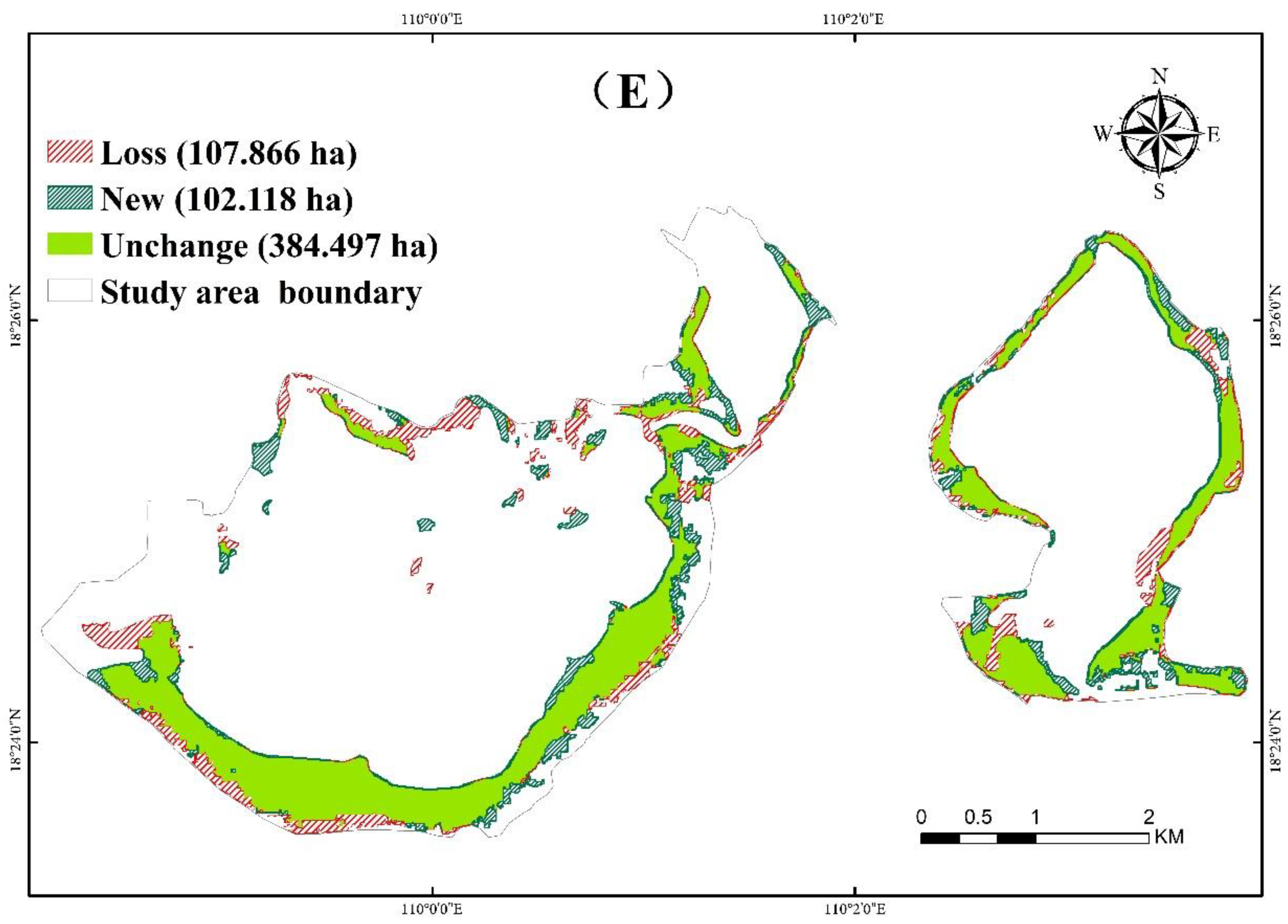



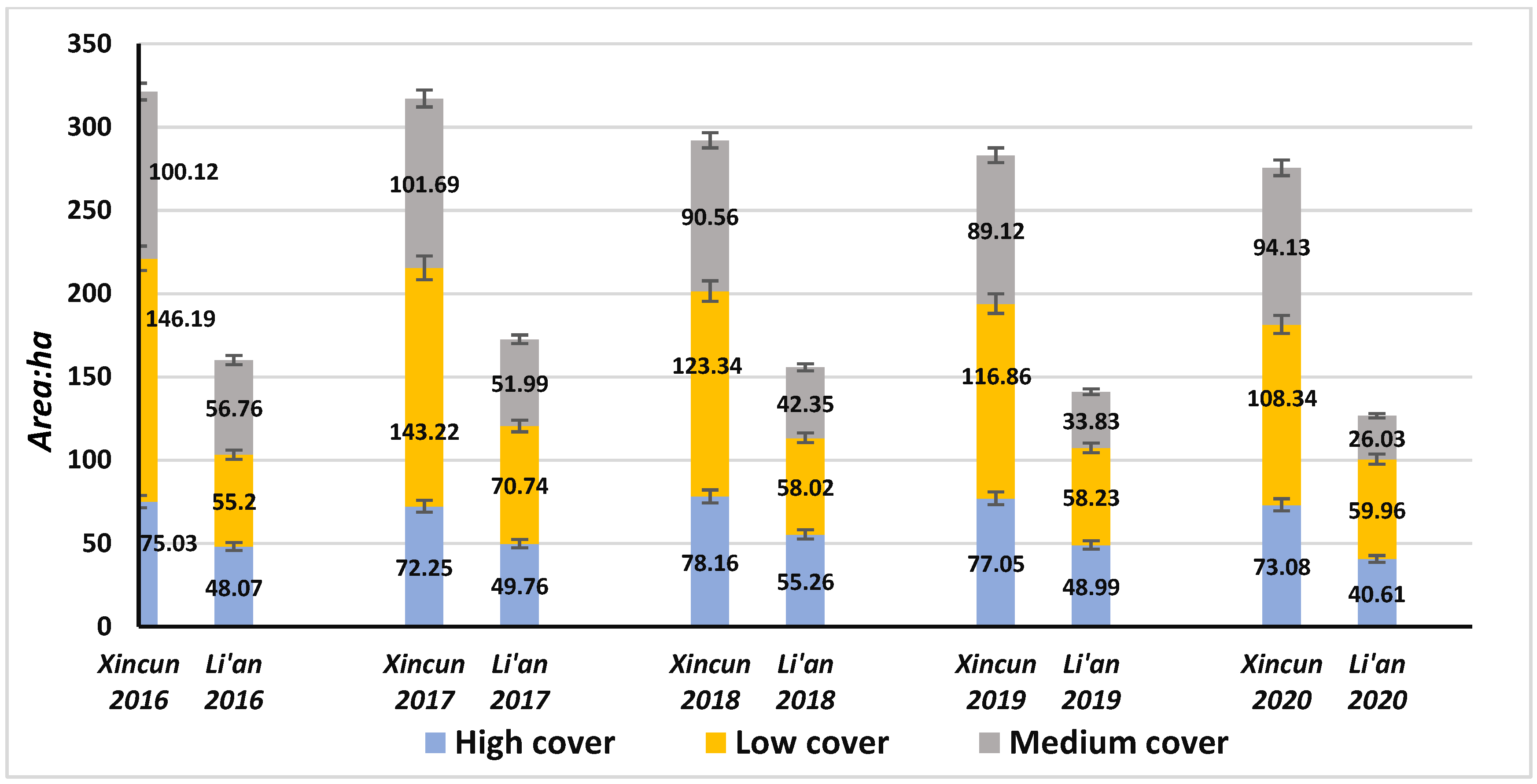
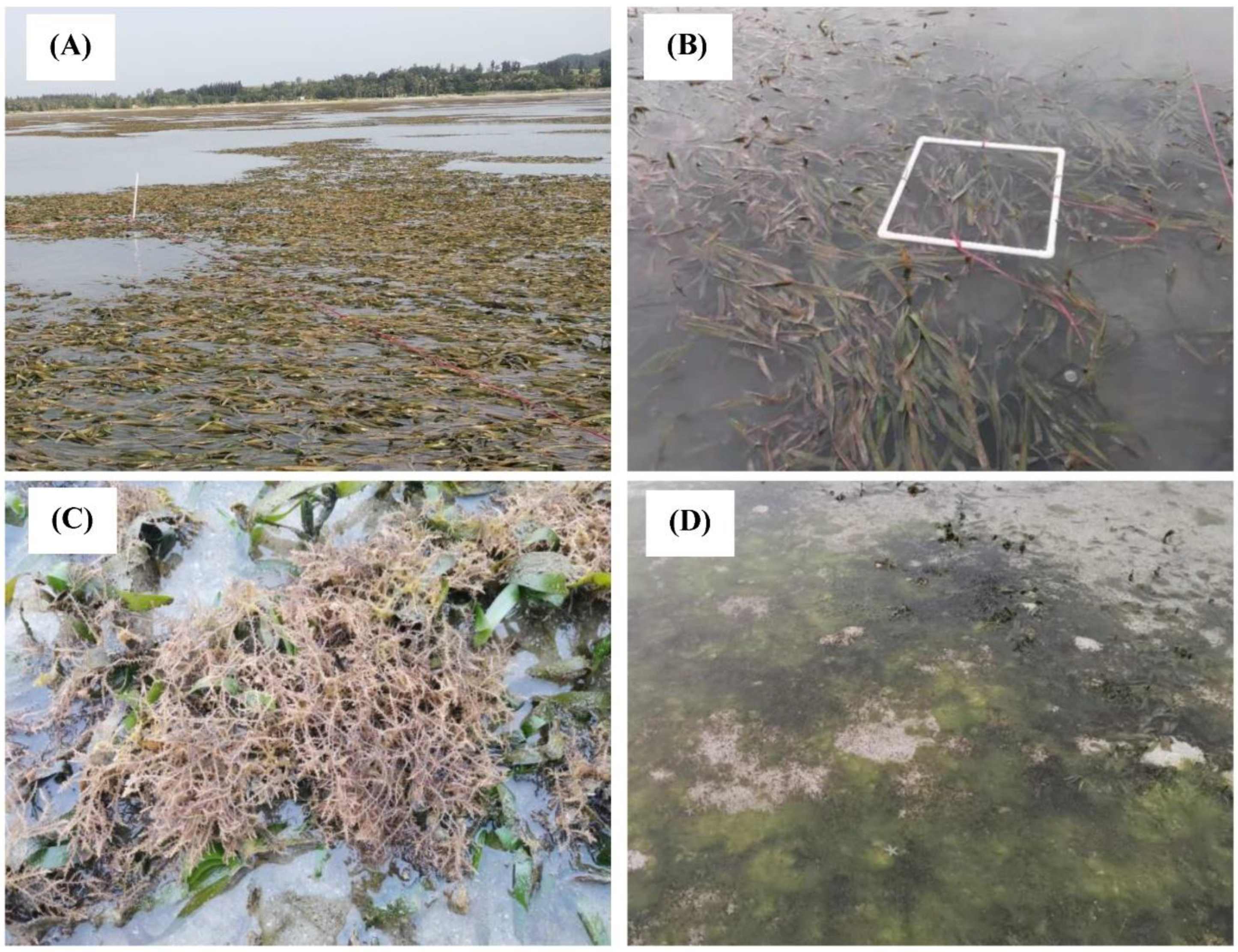
| Band No. | Spectral Band | Spectral Range (μm) | Spatial Resolution (m) | Width (km) | Experimental Data Date | |
|---|---|---|---|---|---|---|
| PA | 1 | Panchromatic | 0.45–0.90 | 1 | 45 | 10 August 2020 |
| MSI | 2 | Blue | 0.45–0.52 | 4 | ||
| 3 | Green | 0.52–0.59 | ||||
| 4 | Red | 0.63–0.69 | ||||
| 5 | NIR | 0.77–0.89 |
| Band No. | Spectral Band | Central Wavelength (μm) | Spatial Resolution (m) | Experimental Data Date |
|---|---|---|---|---|
| 1 | Coastal aerosol | 0.443 | 60 | 9 December 2016 19 December 2017 30 October 2018 4 December 2019 28 December 2020 |
| 2 | Blue | 0.490 | 10 | |
| 3 | Green | 0.560 | 10 | |
| 4 | Red | 0.665 | 10 | |
| 5 | Vegetation red edge | 0.705 | 20 | |
| 6 | Vegetation red edge | 0.740 | 20 | |
| 7 | Vegetation red edge | 0.783 | 20 | |
| 8 | NIR | 0.842 | 10 | |
| 8A | Narrow NIR | 0.865 | 20 | |
| 9 | Water vapor | 0.945 | 60 | |
| 11 | SWIR | 1.610 | 20 | |
| 12 | SWIR | 2.190 | 20 |
| Class Type | Description |
|---|---|
| Seagrass high-cover areas | >80% seagrass coverage in the pixel |
| Seagrass medium-cover areas | >50%, <80% seagrass coverage in the pixel |
| Seagrass low-cover areas | >20%, <50% seagrass coverage in the pixel |
| Sandy areas | <20% seagrass, >80% bare sand coverage in the pixel |
| Other mixed substrates | Mixed coverages of very little seagrass, seaweed, sand, and gravel in the pixel |
| Water bodies | The water body area |
| Turbid water bodies | Turbid water body and polluted water area |
| Aquaculture farms | Fishing rafts and nets area used for aquaculture |
| Data | Image Features | Visual Estimation of Seagrass Coverage (%) | Image Features | Visual Estimation of Seagrass Coverage (%) | Image Features | Visual Estimation of Seagrass Coverage (%) |
|---|---|---|---|---|---|---|
| Sentinel-2 |  | 100% |  | 76% |  | 35% |
| GF2 |  | 95% |  | 75% |  | 40% |
| Sentinel-2 |  | 88% |  | 55% |  | 20% |
| GF2 |  | 86% |  | 57% |  | 25% |
| Class | Prod. Acc. (Percent) | User Acc. (Percent) | Prod. Acc. (Pixels) | User Acc. (Pixels) |
|---|---|---|---|---|
| Water bodies | 91.71 | 83.01 | 2986/3256 | 2986/3597 |
| Turbid Water bodies | 82.18 | 76.48 | 959/1167 | 959/1254 |
| Aquaculture farms | 73.63 | 76.51 | 863/1172 | 963/1128 |
| Seagrass high-cover areas | 77.48 | 86.21 | 1338/1727 | 1338/1552 |
| Seagrass low-cover areas | 77.98 | 63.16 | 1190/1526 | 1190/1884 |
| Seagrass medium-cover areas | 56.93 | 97.21 | 698/1226 | 698/718 |
| Sandy areas | 100 | 73.86 | 1023/1023 | 1023/1385 |
| Other mixed substrates | 43.72 | 74.09 | 449/1027 | 449/606 |
| Overall Accuracy | (9506/12,124) = 78.407% | |||
| Kappa Coefficient | 0.744 | |||
| Class | Prod. Acc. (Percent) | User Acc. (Percent) | Prod. Acc. (Pixels) | User Acc. (Pixels) |
|---|---|---|---|---|
| Water bodies | 95.14 | 77.2 | 3074/3231 | 3074/3982 |
| Turbid Water bodies | 81.21 | 90.38 | 977/1203 | 977/1081 |
| Aquaculture farms | 79.2 | 94.73 | 952/1202 | 952/1005 |
| Seagrass high-cover areas | 91.2 | 92.04 | 1503/1648 | 1503/1633 |
| Seagrass low-cover areas | 82.08 | 81.75 | 1232/1501 | 1232/1507 |
| Seagrass medium-cover areas | 65.55 | 100 | 805/1228 | 805/805 |
| Sandy areas | 100 | 64.78 | 1008/1008 | 1008/1556 |
| Other mixed substrates | 45.42 | 100 | 456/1004 | 456/456 |
| Overall Accuracy | (10,007/12,025) = 83.218% | |||
| Kappa Coefficient | 0.7999 | |||
Publisher’s Note: MDPI stays neutral with regard to jurisdictional claims in published maps and institutional affiliations. |
© 2022 by the authors. Licensee MDPI, Basel, Switzerland. This article is an open access article distributed under the terms and conditions of the Creative Commons Attribution (CC BY) license (https://creativecommons.org/licenses/by/4.0/).
Share and Cite
Li, Y.; Bai, J.; Zhang, L.; Yang, Z. Mapping and Spatial Variation of Seagrasses in Xincun, Hainan Province, China, Based on Satellite Images. Remote Sens. 2022, 14, 2373. https://doi.org/10.3390/rs14102373
Li Y, Bai J, Zhang L, Yang Z. Mapping and Spatial Variation of Seagrasses in Xincun, Hainan Province, China, Based on Satellite Images. Remote Sensing. 2022; 14(10):2373. https://doi.org/10.3390/rs14102373
Chicago/Turabian StyleLi, Yiqiong, Junwu Bai, Li Zhang, and Zhaohui Yang. 2022. "Mapping and Spatial Variation of Seagrasses in Xincun, Hainan Province, China, Based on Satellite Images" Remote Sensing 14, no. 10: 2373. https://doi.org/10.3390/rs14102373
APA StyleLi, Y., Bai, J., Zhang, L., & Yang, Z. (2022). Mapping and Spatial Variation of Seagrasses in Xincun, Hainan Province, China, Based on Satellite Images. Remote Sensing, 14(10), 2373. https://doi.org/10.3390/rs14102373







